On September 24th, 2019, Google released a broad core algorithm update (dubbed the September 2019 Core Update) – making it the third official algorithm update of 2019 and like all updates, brought forth a number of puzzles and challenges to solve.
Whilst the greater core of the client sites I work on either saw the positive or neutral impact, my personal website, this website, was negatively affected.
I started this blog post on November 14th, 2019 and have spent a number of weeks making changes to the website and seeing recovery off the back of the January 2020 core algorithm update. I can confidently say the following:
I have no idea how much of the recent uplift is a result of Google changing things, or rewarding my changes. There were some positive performance gains following changes I made, but the most substantial uplift has been since the algo update.

However, based on the assumption that Google’s core algo updates are all pulling in the same direction and towards a longer-term goal – the changes I’ve made to better align my site and content with what Google is supposedly after (based on various studies, experiments, and analysis both done by myself and a plethora of other SEOs) – so surely none of the changes made could have hurt.
Update February 3, 2020
It would appear that the recovery is now at the levels it was prior to the September 2019 update:
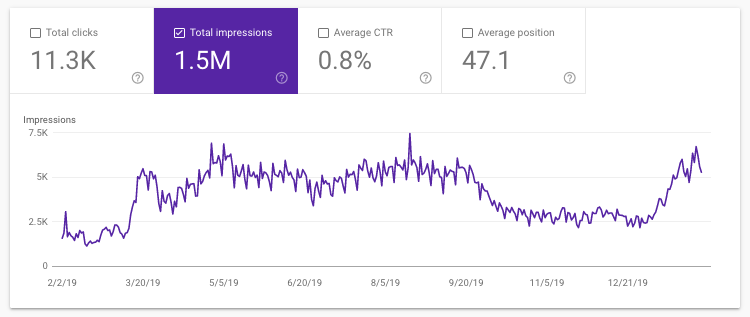
I’m going to continue implementing the “fixes” that I believe are aiding the uplift, and not just relying on Google’s goodwill.
Below is a top-level summary of the drop itself and how I went around identifying the issue areas.
Following the analysis, I made a number of site changes, including:
- Content removal. Blog posts and pages which didn’t rank for anything or have any traction, I just removed from the website and redirected.
- Cut losses. Some phrases (and topics) I used to have traction for such as EKM and SEO + Glasgow, never brought in any leads or traffic of value – so I removed the commercial page for EKM, and removed references to Glasgow to try and deoptimize for the term. Likewise, Hreflang Checker is a tool that was a project from 2018, and lives on another domain – so for user intent, it’s better for that site to rank ahead of mine.
- Content improvements. I lost a lot of traction around Naver, and Naver search related terms. So I worked on improving and updating my Naver related content with any new information and expanded on previous points. I also worked on content across other pages to refresh them. Interestingly I also removed dates from some content pieces, e.g. the 2018 Guide to X, just became the Guide to X – with this I think it’s a pure correlation that performance improved and not the date removal.
- Page load speed improvements. To improve page load speeds, I improved site caching, as well as compressed all images across the site.
The Traffic Drop

You can read more about the September Core Update here, however, in this article I’m going to go through the process of identifying where I’ve seen the decline in both Google Search Console and Google Analytics, and then the steps and thought processes, as well as some of the steps taken to reverse the trend – and their impacts (at the time of the post).
In terms of metrics, I’m looking at month-to-month organic traffic in October being down 20% versus September, and Google Search Console showing large decreases in impressions and clicks.

All of the data I’m using in this article is my own, it’s unfiltered, and being shared in good faith. I’m also aware everyone has different approaches to diagnosing these issues and being honest, my approach to a site I didn’t know so very well would differ – but I at least have the benefit of having built this site from the ground up.
Diagnosing The Decreases
How, Where, Why
Looking at month-to-month organic traffic in October was down 20% versus September (220 sessions), and a net loss in impressions from GSC of 47,816 (133,894 in September v 86,078 in October). By ascertaining how big the loss is, and identifying the loss areas I can begin to understand how to put in place a recovery plan from a data-led, strategic perspective.
Using the Google Search Console API, I’ve pulled out my search queries and URLs versus the number of impressions they’ve received on a weekly basis over the past 12 months (so I can visualize longer-term trends) and then compared September to October, or in other words pre and post Algo update.
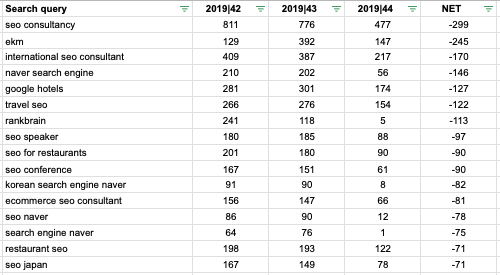
The next phase is diagnosing which keywords I actually care about. Naturally, websites rank for a wide variety of search phrases and through content and articles, you rank for stuff that doesn’t actually matter. For example, [google hotels], I’ve written a couple of articles about hotel SEO, and about Google’s native travel industry products – so I’ve then also gained visibility for [google hotels]. Whilst some of the results on page one are relevant to my content, I’m not going to lose sleep over this keyword.
Similarly, I’ve seen large decreases for the below keywords and topic areas:
- EKM
- Naver Search Engine
- Hreflang Checker
- London
- SEO Consultant Glasgow
- Machine Learning SERP Features
- SEO Grimsby
Some of the above I’ve targeted variants of, such as EKM SEO, and others I’ve picked up through content, such as Hreflang Checker (I’d rather my actual Hreflang Checking Tool ranked for that keyword ahead of my site) and SEO Consultant Glasgow.
However, by comparison, keywords like SEO Consultancy, International SEO Consultant, Ecommerce SEO Consultant, and SEO Naver, I do care about.
Using this keyword data, I can then match it to URL decreases:
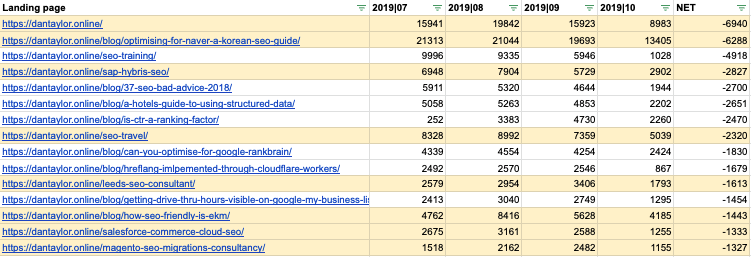
So from this initial list, the URLs I care about that have lost impressions (and performance) are:
- https://dantaylor.online/blog/optimising-for-naver-a-korean-seo-guide/
- https://dantaylor.online/blog/seo-guide-for-the-travel-industry/
- https://dantaylor.online/seo-travel/
- https://dantaylor.online/blog/how-seo-friendly-is-ekm/
- https://dantaylor.online/blog/guide-japanese-seo/
- https://dantaylor.online/sap-hybris-seo/
- https://dantaylor.online/international-seo/
- https://dantaylor.online/salesforce-commerce-cloud-seo/
The core themes you may have noticed here are around International, E-commerce, and Travel SEO.
It’s also worth noting that whilst the biggest impact correlates with the September update, some of the URLs have been on the slide for a couple of months.
Specific Keyword/SERP Changes
Sometimes it’s easier to look at organic traffic on a site-wide level and then go granular, but when trying to ascertain the causes of a traffic drop and I can see that it’s predominantly related to specific URLs, I like to go granular first.
Having looked over the main search phrases were I appear to have lost traffic, there doesn’t appear to be any significant changes in the SERPs.
- The localization level/number of map packs seems to be the same
- No new knowledge graph elements
- No new featured snippets
- No new SCRBs such as people also asked, people also search for…
Competitor Changes
Another important consideration is if competitor sites have made any changes.
When I say competitors, I don’t mean other consultant websites who are my direct competitors, but the competitors for the keywords where I have lost traffic.
One of the areas I’ve seen loss is around the platform EKM, so terms like [ekm seo], [ekm powershop seo], [is ekm seo friendly]… And for a long time, my EKM SEO post remained in the first position, virtually unchallenged. However, on September 26t 2019 EKM themselves published a piece targeting the same phrases, and built it out with a lot of EKM’s SEO capabilities, examples of successful EKM stores in organic search, and so on.
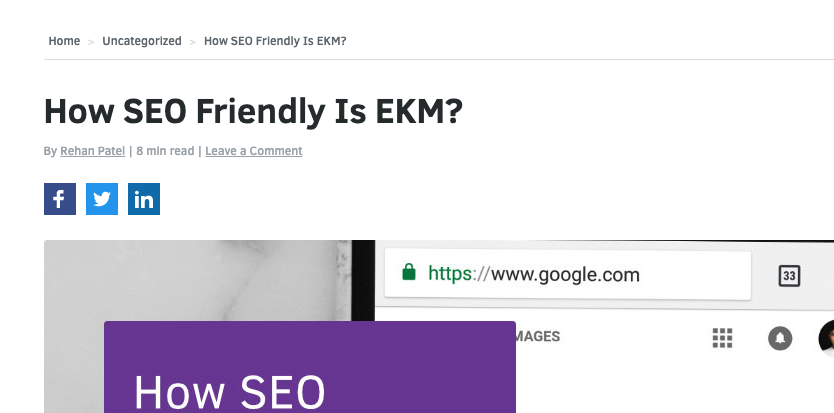
This now ranks in 1st position, and a second (existing article) which was featured in my post for its inaccuracies has moved to second. I’m now ranking behind the brand, for a brand compound phrase.
This then leads to two questions:
- Is it likely I can get back 1st or 2nd place for a brand phrase from the brand?
- Is it worth the effort to rank for EKM from a business sense (given EKM’s market positioning?)
The answer to both is likely not. I still hold position 3, and informed users will read multiple platform reviews – especially given only two exist, and only one is independent.
Underlying Technical Issues
As with any change in site traffic, it’s important to not jump to assumptions and just assume it’s down to the broad core algorithm update based on timings.
So, we first ask some initial exploratory questions:
- Have you made any major changes to the site or development pushes in the past 6 months?
- Have you amended any of the landing pages that have seen a decrease in traffic?
- Are there any major, underlying technical problems?
- Have there been any unintended changes to the site?
From these questions, more questions may arise – but from these, you can start to build a better picture of the site history.
So the answers to the questions above, in order: No, No, Not Really, No.
The final question, around unintended changes, might not be able to be answered by the greater majority of clients, but I use ContentKing, so I get notifications every time my site sneezes.

Between the uptick in January 2020 to now, I’ve pretty much neglected my own website in terms of posting content regularly as I’ve been blogging elsewhere and started to do the YouTube thing.
So what does the second rollercoaster look like? This:
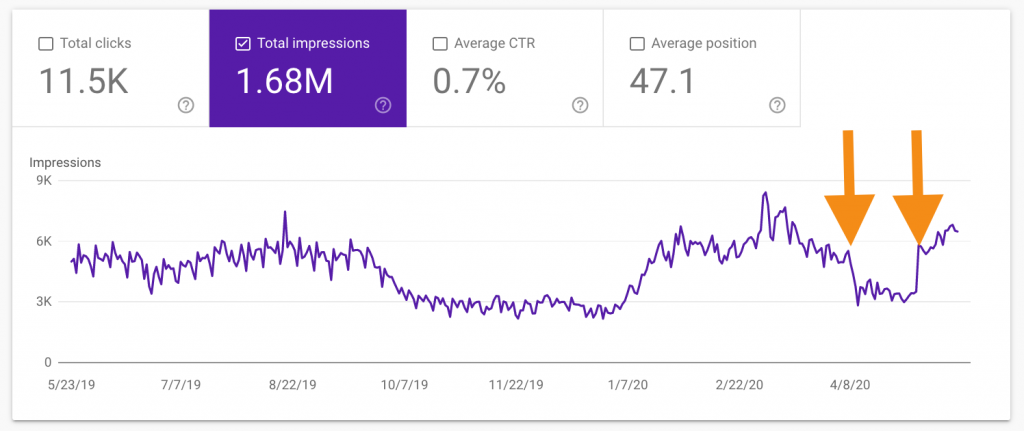
The two dates the arrows point to are April 7th 2020 and May 4th 2020.
Now we know that there was an update on May 4th, and SERoundTable did report some flutters on the week before, but there’s not much reported for April 7th (which does tie in with Barry S taking some deserved time off and posts going out that week being scheduled).
Analyzing The Ride
Ahead of most Google changes, there can sometimes be “warning signs”. I know that Google rolls out updates pretty much all the time to various SERPs, individual queries, and even whole parts of the algorithm. Based on the data available in multiple GSCs available to me, and third-party volatility tools, I believe there was a change made in and around April 7th – and across multiple queries.
For example, this is a local entertainment agency (already taking a hit from Corona) but again seeing a sudden drop around April 7th and then some small recovery at the start of May:

And then a blog website which saw a drop on April 8th, and then a further drop on May 4th:
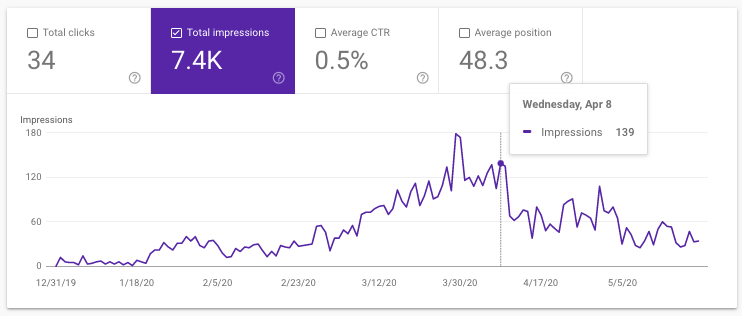
There are other examples correlating the April 7th and May 4th trends, but, I can’t really share their GSC screenshots.
Another time period that became suspicious quickly was that of April 11 to April 28th… As the below graph shows:

This isn’t a traffic-driving keyword so wouldn’t have shown in the normal reporting, and as far as I can tell (from using tools like ContentKing), and other data from GA – the page that corresponds with this keyword had no issues during this period and had no changes made to the content or meta.
Analyzing The Data
So looking through my data, what are the immediate observations…
I lost impressions for and then regained impressions for the below terms between April 7th and May 4th
- SEO Consultancy
- SEO site audit
- Site audit
- YouTube SEO (which I have one blog post about, so not surprised)
- How to rank videos on YouTube
On April 7th I saw improvements for the below keywords, which have been sustained since:
- eCommerce SEO consultant
This is where it’s important to note that GSC data does differ from Google Analytics, as in real terms I didn’t lose half my organic traffic over the period:

What Did The Core Algo Affect
So, getting the obvious question out of the way – what did I do post-April 7th to ascertain why my impressions had almost halved overnight? The answer, nothing.
During the period of April 7th to March 4th, looking at the sites now ranking for my important, traffic-driving terms I could kind of understand why I had lost performance, and the answer wasn’t to make a kneejerk response as the sites (and content) now ranking had invested more content and PR over a period of time, and I hadn’t.
Like most things core algorithm updates “change”, the data is built up over a long period of time, such as long click v short click data, and given how queries and users can change behavior and expectations it is almost impossible to identify vulnerability to or prepare for over a long period of time – aside from glaringly obvious issues such as:
- Bad technical
- Content not matching user expectations or the query
- Increased competition activities
Based on the observations from the three sites above, and multiple other websites and data set my conclusion is that this core update has been much like any other:
- RankBrain has likely gotten better through processing an unimaginable volume more of data
- More time has passed for evaluators to feedback into the algorithm to refine the accuracy
- A virus struck the world, so people’s lifestyles changed, and therefore their internet behaviors
- Data aggregated over a long period of time, such as short click v long click, will have been factor along with the change in user behavior
- All websites will have been making some form of effort (high or low) to move the needle, and oftentimes a core update such as this rebalances the SERPs and if you have been making high efforts you can see a reward
And, as always, sometimes some things make no sense – and, as always, the issue might not be related to your “SEO” in a silo, but also your marketing/PR/branding/social and the sentiment in which people talk about you online (down to your products, customer service, issue handling, etc).